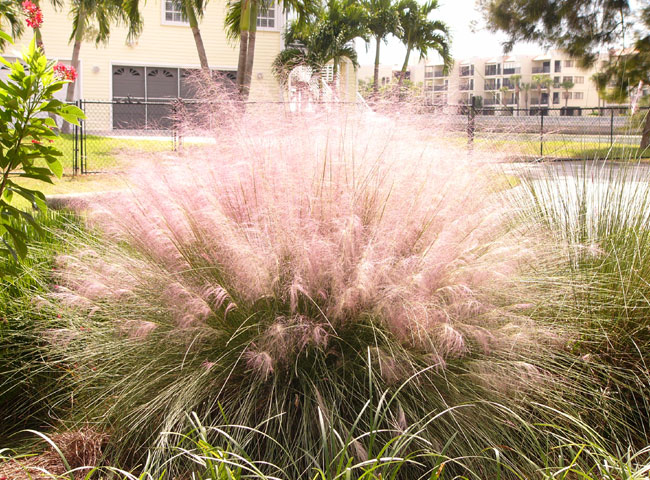If you really want a versatile ornamental grass that will put on a spectacular show in your garden, then you don’t need to look further than Muhly Grass. This hardy and easy to grow grass creates a wonderful flair of showy cotton-candy pink cloud of flowers each fall. In this post you will get valuable tips on growing and caring for Muhly Grass.
What is Muhly Grass?
With the scientific name, Muhlenbergia capillaris, this plant has long foliage blades that can reach 3 to 4 feet tall and up to 3 feet wide when mature. Muhly Grass is native to Florida and the eastern half of the United States. According to the U.S. Department of Agriculture, this perennial plant flourishes in zones 7 through 11 and it is also hardy to Zone 6 with protection. Muhly Grass looks like normal clumps of dark-green grass throughout the growing season but it creates vibrant pink to purple billowy inflorescences in the fall. The feathery flowers float above the body of the plant in an airy display. There is also a white flowering variety. Garden designers often plant Muhly Grass in large groups for a stunning visual effect.
Preferred Site Conditions For Muhly Grass
Muhly Grass can be grown throughout Florida as a solitary plant or as mass median plantings. It is also used commonly in golf course landscaping and in rain gardens Plant several together but they should be spaced at least 24 to 36 inches apart for aesthetic impact.
Zones: 7 – 10
Moisture timing: When freshly planted, it needs supplemental irrigation to help the grass grow taller.
Soil: Tolerant of a range of soil conditions alkaline to acid, sandy soils, sandy, sandy loam. It works well even in poor soils as groundcover. Moreover this plant can tolerate salt spray generally found in coastal settings.
Light: Full sun – light shade
How to Grow Ornamental Muhly Grass
Follow these simple tips from our planting expert at Wilcox Nursery and Landscaping to enjoy great landscaping with Muhly Grass faster.
- Muhly Grass is best planted in a bright, sunny area of your garden, just like other ornamental grasses.
- Water new plants until they are established. After that, they’ll have good drought tolerance.
- Remove rocks or weeds from a bright sunny area of your garden. You must make enough space for 2 to 3 feet between the centers of each Muhly Grass clump you plant. Muhly Grass is adaptable to all soil types and areas with slow drainage, though soil that drains well is preferred.
- Dig a hole for each Muhly Grass plant about two to three times the width of the plant’s root ball and no deeper than the height of the root ball’s height.
- Turn your nursery pots of Muhly Grass on their sides, and push up on the flexible bottoms to loosen the plants before placing it in the hole, with the crown slightly above the surrounding soil.
- Water the soil to ensure the plant’s root ball is thoroughly soaked. Wait for the water to soak in, and then fill around the plants with soil and firm it with your hands. The plant will need at least an inch of water each week during the first growing season. But the soil should not be soggy.
Care of Muhly Grass
Growing Muhly Grass is easy as it requires little maintenance or upkeep. You do not have to water once the grass matures. Muhly Grass does look better and flowers abundantly with periodic supplemental irrigation during periods of drought.
Though the grass is semi-evergreen, dead growth should be moved at the base of the clump. Lift the grass blades up and gently pull the loose dead duff of brown dead leaves away from the clump. The grass will look better and this helps to keep it healthy. Note that hard pruning is not recommended for mature muhly grass.
Although usually not necessary, you can also nourish the plants in spring with a diluted by half balanced plant food and water when the soil appears dry in the top couple of inches. That’s all there is to caring for this beautiful grass.


